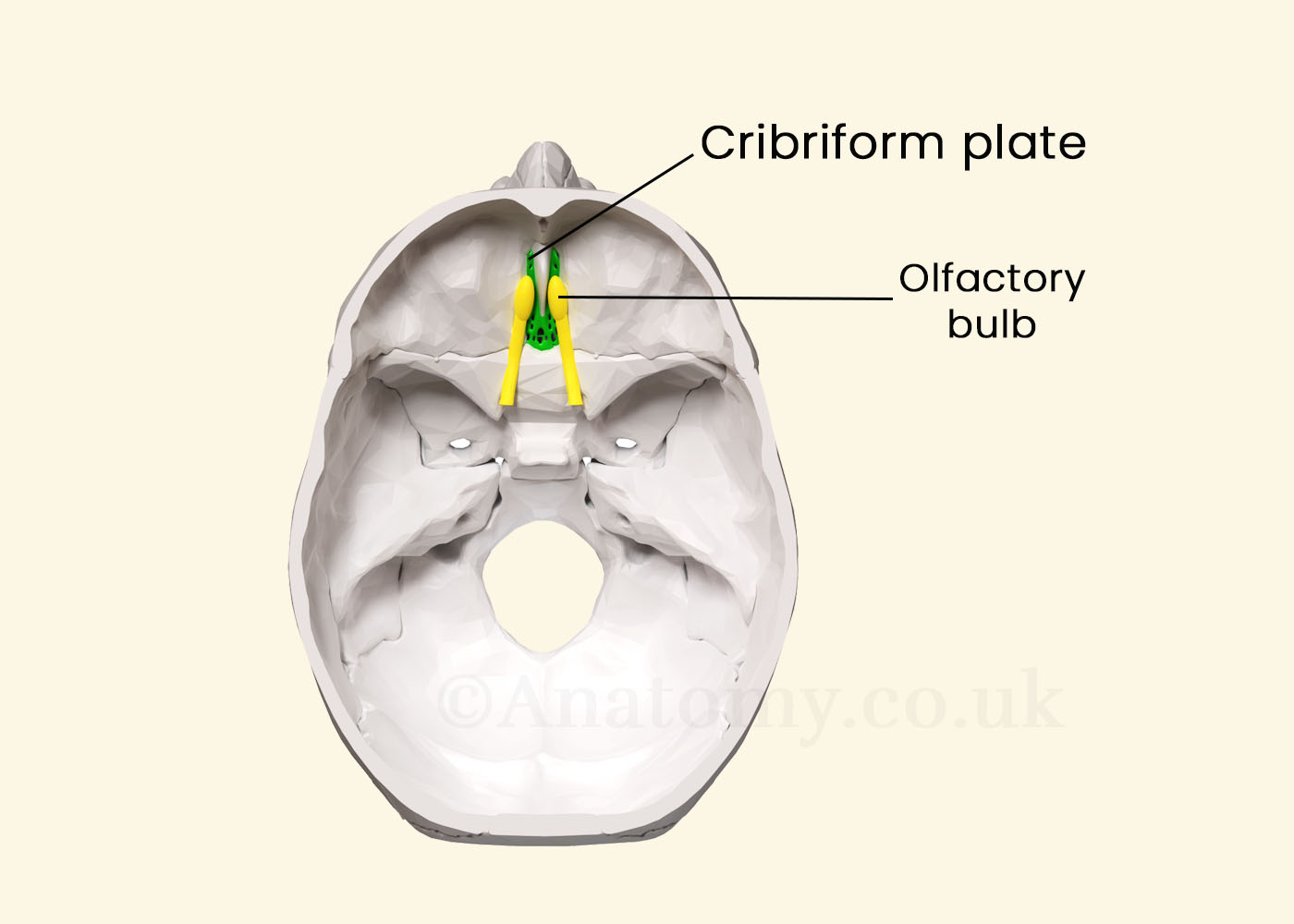CP
Cribriform plate
Part of ethmoid bone with holes for olfactory nerves
RegionNeuroanatomy
System-
The cribriform plate, also known as the olfactory perforated plate or lamina cribrosa olfactoria, is a small but crucial structure located in the roof of the nasal cavity in the human head. It plays a vital role in the sense of smell, as it houses the olfactory nerve fibers that are responsible for transmitting sensory information from the nose to the brain.
Structure
The cribriform plate is a thin, bony structure that is located at the anterior portion of the skull base, in the midline. It forms the roof of the nasal cavity and separates the brain from the nasal cavity. The cribriform plate is made up of compact bone, which is a dense and hard type of bone that provides structural support and protection. It has a horizontal orientation and is oval in shape. It is approximately 2.5 cm in length and 1 cm in width. The cribriform plate is made up of three parts: the anterior, middle, and posterior parts. The anterior part of the cribriform plate is the thinnest and most fragile, while the posterior part is the thickest and strongest. The cribriform plate has a number of small, round openings, called foramina, which are located throughout its surface. These openings allow the olfactory nerve fibers to pass through the cribriform plate and reach the olfactory bulbs in the brain. The foramina are arranged in a regular pattern, with the largest foramina located at the center of the cribriform plate and the smaller foramina located towards the edges.Diagram

Picture 1: Diagram showing Cribriform plate and Olfactory bulb
Location
The cribriform plate is located in the roof of the nasal cavity, at the anterior portion of the skull base. [1]It is situated just beneath the frontal bone and the ethmoid bone, which are two bones that make up the front part of the skull. The cribriform plate is located above the nasal septum, which is the partition that divides the nasal cavity into two halves. It is also located in close proximity to the brain, with the olfactory bulbs lying just beneath it. The olfactory bulbs are part of the brain's olfactory system, which is responsible for processing and interpreting sensory information related to smell.Function
The primary function of the cribriform plate is to house and protect the olfactory nerve fibers, which are responsible for transmitting sensory information related to smell from the nose to the brain. The olfactory nerve fibers are a type of sensory neuron that are specialized for detecting and transmitting information about odors.[8] When we inhale air through the nose, odorous molecules in the air bind to receptors on the surface of the olfactory epithelium, a specialized tissue located in the roof of the nasal cavity. This binding activates the olfactory nerve fibers, which transmit this sensory information to the olfactory bulbs in the brain via the cribriform plate. The olfactory bulbs then process this information and send it to other areas of the brain, such as the amygdala and the hippocampus, which are involved in emotional and memory processing.[2] This enables us to perceive and identify different odors, and associate them with memories and emotions. In addition to its role in the sense of smell, the cribriform plate also serves as a barrier between the nasal cavity and the brain, protecting the brain from foreign substances that may enter the nasal cavity through the nose.[3]Clinical significance
There are several clinical conditions that can affect the cribriform plate and disrupt its function. One such condition is olfactory neuroblastoma, which is a rare type of cancer that affects the olfactory nerve fibers and the surrounding tissues. [4]Olfactory neuroblastoma typically arises from the olfactory epithelium and can spread to the cribriform plate and other nearby structures, such as the ethmoid bone and the frontal sinuses. Another condition that can affect the cribriform plate is cribriform plate injury, which can occur as a result of trauma to the head, such as a blow to the face or a fall.[5] Cribriform plate injury can range in severity, from a simple fracture to a complete disruption of the plate. Finally, the cribriform plate can also be affected by infectious conditions, such as sinusitis, which is an inflammation of the sinuses.[6] Sinusitis can cause swelling and inflammation of the tissues surrounding the cribriform plate, leading to congestion, difficulty breathing through the nose, and loss of sense of smell. Treatment options for sinusitis may include antibiotics, decongestants, and nasal irrigation.[7]Published on June 9, 2023
Last updated on April 24, 2025
Last updated on April 24, 2025